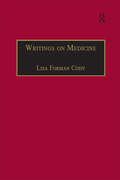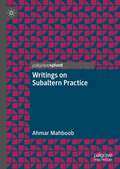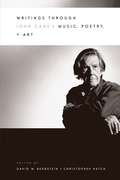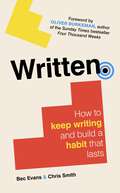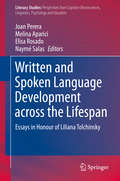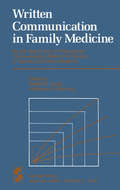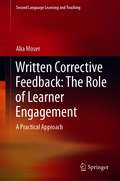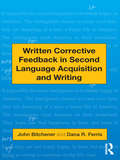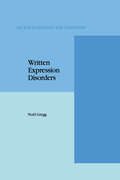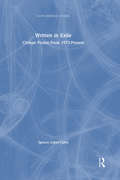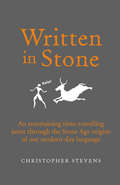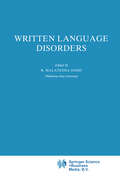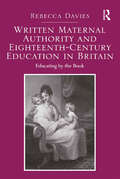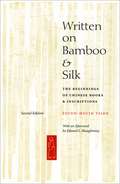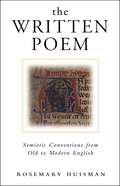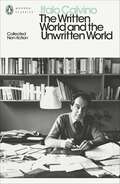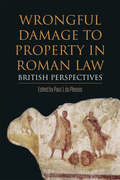- Table View
- List View
Writings on Medicine: Printed Writings 1641–1700: Series II, Part One, Volume 4 (The Early Modern Englishwoman: A Facsimile Library of Essential Works & Printed Writings, 1641-1700: Series II, Part One)
by Lisa Forman CodyThe four works in this volume are the only known exclusively medical texts written by women during the Restoration. Their importance is denoted by their dramatic challenge to the generalisations once made about medical practice and female healers in this period. Jane Sharp's The Midwives Book was the first and only midwifery manual to be printed in English before 1700, and continued to be influential into the early eighteenth century. The principal focus of Elizabeth Cellier's To Dr.--- (1688) is the attempt to legitimate the notion of a female corporation of midwives through historical precedent. To Dr.--- was in fact borne out of a previously unpublished effort, 'A Scheme for the Foundation of a Royal Hospital', sent to James II in 1687. In the document, Cellier outlined a specific scheme for training female midwives and supporting poor, pregnant women and abandoned children. Mary Trye began practising 'chymical physic' at her father's side in London in 1663. Her only known work, Medicatrix, was published in 1675. Trye claimed female medical authorship to be unique, in that women observed nature truly and administered genuine medical solutions to the sick. The writings of Sharp, Cellier and Trye have helped to overturn historians' assumptions about a woman's role in medicine and healing. These texts reveal their female authors to be as learned in the humanities and sciences as they were in medical matters.
Writings on Medicine: Printed Writings 1641–1700: Series II, Part One, Volume 4 (The Early Modern Englishwoman: A Facsimile Library of Essential Works & Printed Writings, 1641-1700: Series II, Part One)
by Lisa Forman CodyThe four works in this volume are the only known exclusively medical texts written by women during the Restoration. Their importance is denoted by their dramatic challenge to the generalisations once made about medical practice and female healers in this period. Jane Sharp's The Midwives Book was the first and only midwifery manual to be printed in English before 1700, and continued to be influential into the early eighteenth century. The principal focus of Elizabeth Cellier's To Dr.--- (1688) is the attempt to legitimate the notion of a female corporation of midwives through historical precedent. To Dr.--- was in fact borne out of a previously unpublished effort, 'A Scheme for the Foundation of a Royal Hospital', sent to James II in 1687. In the document, Cellier outlined a specific scheme for training female midwives and supporting poor, pregnant women and abandoned children. Mary Trye began practising 'chymical physic' at her father's side in London in 1663. Her only known work, Medicatrix, was published in 1675. Trye claimed female medical authorship to be unique, in that women observed nature truly and administered genuine medical solutions to the sick. The writings of Sharp, Cellier and Trye have helped to overturn historians' assumptions about a woman's role in medicine and healing. These texts reveal their female authors to be as learned in the humanities and sciences as they were in medical matters.
Writings on Subaltern Practice
by Ahmar MahboobSubaltern theory emerged as a small voice within academia decades ago. Over time, this work generated significant debate and numerous publications, talks, and conferences. However, little has changed in the experienced lives of the masses. This led people to wonder: “the subalterns seem to have a voice, but can they take action?”; or, in other words, is there subaltern practice?This collection of essays and poems, written with a broad audience in mind, hopes to demonstrate not just how the subaltern can identify and question hegemonic practices, but how they can create alternative frameworks and material that enable themselves and their communities. In doing so, this book aims to demonstrate not just how deep the colonial poisons run, but also how to detoxify ourselves and the environment around us.The writings included in this book study the inequalities that we experience in and around us and suggest actions and practices that can help us regain harmony. It is a call for action and a sharing of ideas that can enable us to regain balance and fulfil our human responsibilities.
Writings through John Cage's Music, Poetry, and Art
by David W. Bernstein Christopher HatchThis volume looks at the creative work of the great avant-gardist John Cage from an exciting interdisciplinary perspective, exploring his activities as a composer, performer, thinker, and artist. The essays in this collection grew out of a pivotal gathering during which a spectrum of participants including composers, music scholars, and visual artists, literary critics, poets, and filmmakers convened to examine Cage's extraordinary artistic legacy. Beginning with David Bernstein's introductory essay on the reception of Cage's music, the volume addresses topics ranging from Cage's reluctance to discuss his homosexuality, to his work as a performer and musician, and his forward-looking, provocative experimentation with electronic and other media. Several of the essays draw upon previously unseen sketches and other source materials. Also included are transcripts of lively panel discussions among some of Cage's former colleagues. Taken together, this collection is a much-needed contribution to the study of one of the most significant American artists of the twentieth century.
Writings through John Cage's Music, Poetry, and Art
by David W. Bernstein Christopher HatchThis volume looks at the creative work of the great avant-gardist John Cage from an exciting interdisciplinary perspective, exploring his activities as a composer, performer, thinker, and artist. The essays in this collection grew out of a pivotal gathering during which a spectrum of participants including composers, music scholars, and visual artists, literary critics, poets, and filmmakers convened to examine Cage's extraordinary artistic legacy. Beginning with David Bernstein's introductory essay on the reception of Cage's music, the volume addresses topics ranging from Cage's reluctance to discuss his homosexuality, to his work as a performer and musician, and his forward-looking, provocative experimentation with electronic and other media. Several of the essays draw upon previously unseen sketches and other source materials. Also included are transcripts of lively panel discussions among some of Cage's former colleagues. Taken together, this collection is a much-needed contribution to the study of one of the most significant American artists of the twentieth century.
Writings through John Cage's Music, Poetry, and Art (Phoenix Fiction Ser.)
by David W. Bernstein Christopher HatchThis volume looks at the creative work of the great avant-gardist John Cage from an exciting interdisciplinary perspective, exploring his activities as a composer, performer, thinker, and artist. The essays in this collection grew out of a pivotal gathering during which a spectrum of participants including composers, music scholars, and visual artists, literary critics, poets, and filmmakers convened to examine Cage's extraordinary artistic legacy. Beginning with David Bernstein's introductory essay on the reception of Cage's music, the volume addresses topics ranging from Cage's reluctance to discuss his homosexuality, to his work as a performer and musician, and his forward-looking, provocative experimentation with electronic and other media. Several of the essays draw upon previously unseen sketches and other source materials. Also included are transcripts of lively panel discussions among some of Cage's former colleagues. Taken together, this collection is a much-needed contribution to the study of one of the most significant American artists of the twentieth century.
Written: How to Keep Writing and Build a Habit That Lasts
by Bec Evans Chris Smith**With a Foreword by OLIVER BURKEMAN, bestselling author of the Sunday Times bestseller Four Thousand Weeks**Written is a transformative guide that anyone can use to overcome their blocks and build a successful writing habit.Many people think that there's only one 'right' way to get the writing done - or that trying harder is the key. Award-winning writers, productivity coaches and co-founders of Prolifiko Bec Evans and Chris Smith know this isn't true. Having coached over 10,000 writers, they've learned that productivity is personal. Their unique, results-driven approach is designed to help you find a realistic and sustainable practice that will get you to the end of any writing project, no matter how stuck you feel.Applying research from neuroscience and psychology, and based on the authors' own practice and findings, Written will show you how to manage your time effectively, how to visualise and set successful goals, how to recover from setbacks, and ultimately how to create writing habits that work for you. Along the way, you'll hear inspiring and relatable stories from other writers who have overcome their struggles to find success. Each chapter ends with practical coaching exercises that you can start implementing right now. For anyone with a project they need to get written - whether a business book, thesis or work of fiction - this inspiring book offers practical strategies to beat the inner critic, find time, keep motivated and write.
Written and Spoken Language Development across the Lifespan: Essays in Honour of Liliana Tolchinsky (Literacy Studies #11)
by Joan Perera Melina Aparici Elisa Rosado Naymé SalasThis multidisciplinary volume offers insights on oral and written language development and how it takes place in literate societies. The volume covers topics from early to late language development, its interaction with literacy practices, including several languages, monolingual and multilingual contexts, different scripts, as well as typical and atypical development. Inspired by the work of Liliana Tolchinsky, a leading expert in language and literacy development, a group of internationally renowned scholars offers a state-of-the-art overview of current thinking in language development in literate societies in its broadest sense.Contributors offer a personal tribute to Liliana Tolchinsky in the opening section.
Written Communication in Family Medicine: By the Task Force on Professional Communication Skills of the Society of Teachers of Family Medicine
by Katharine A. Munning Robert B. TaylorThis work presents the knowledge and skills necessary for successful written communication in family medicine. It is intended for use by teachers of family medicine who, as part of their academic responsibilities, are called upon to produce written documents in a wide variety of areas. The book has also been written to serve as a resource for leaders presenting faculty development activities in various aspects of written communication, including writing for publication, administrative and educational communication, and other topics of interest to academicians. The Task Force on Professional Communication Skills was formed in 1981 as an initiative of the Board of Directors and the Communications Committee of the Society of Teachers of Family Medicine (STFM). In early meetings, the Task Force defined its goal as improvement of the communication skills-both written and oral-of STFM members. A survey of Task Force members revealed that the greatest challenges lay in the area of written communication skills, although the needs are not confined to medical article and book writing, but extend to the full range of academic communication. The Task Force set as its first task the creation of a monograph on written communication in family medicine.
Written Corrective Feedback: A Practical Approach (Second Language Learning and Teaching)
by Alia MoserThe book provides new insights into written corrective feedback by describing students’ expectations as well as mediating factors that influence their engagement with it. The book draws on an extensive dataset to illustrate secondary school students’ behavioural, cognitive and emotional engagement with written corrective feedback and the extent to which mediating factors, such as teachers, peers, feedback options, attitudes and emotions, foster or hinder it. It shows why teachers need to provide students with the purpose of the corrective feedback they provide, explain how such feedback works and introduce strategies that can be employed to engage with it. Based on the finding that a combination of several feedback types is essential to ensure learner engagement, the book also provides an extensive description and multiple authentic examples of the Engagement-Feedback-Mediator Model that was developed in the context of this study.
Written Corrective Feedback in Second Language Acquisition and Writing
by John Bitchener Dana R. FerrisWhat should language and writing teachers do about giving students written corrective feedback? This book surveys theory, research, and practice on the important and sometimes controversial issue of written corrective feedback, also known as “error/grammar correction,” and its impact on second language acquisition and second language writing development. Offering state-of-the-art treatment of a topic that is highly relevant to both researchers and practitioners, it critically analyzes and synthesizes several parallel and complementary strands of research — work on error/feedback (both oral and written) in SLA and studies of the impact of error correction in writing/composition courses — and addresses practical applications. Drawing from both second language acquisition and writing/composition literature, this volume is the first to intentionally connect these two separate but important lines of inquiry.
Written Corrective Feedback in Second Language Acquisition and Writing
by John Bitchener Dana R. FerrisWhat should language and writing teachers do about giving students written corrective feedback? This book surveys theory, research, and practice on the important and sometimes controversial issue of written corrective feedback, also known as “error/grammar correction,” and its impact on second language acquisition and second language writing development. Offering state-of-the-art treatment of a topic that is highly relevant to both researchers and practitioners, it critically analyzes and synthesizes several parallel and complementary strands of research — work on error/feedback (both oral and written) in SLA and studies of the impact of error correction in writing/composition courses — and addresses practical applications. Drawing from both second language acquisition and writing/composition literature, this volume is the first to intentionally connect these two separate but important lines of inquiry.
Written Expression Disorders (Neuropsychology and Cognition #10)
by N. GreggA critical review of the literature on written expression disorders of individuals with learning disabilities. The purpose of the book is to shed light on issues concerning definition, assessment and interaction for individuals with writing disorders. The integrated model of written expression offered draws on the work of cognitive psychology, neurolinguistics and sociolinguistics. The model illustrates the interrelationship between cognitive and affective processing networks that influence the selection and use of linguistics and information structures in producing a written text. Particularly noteworthy aspects of this book are: the emphasis on the role of writing in developing higher mental functions (other texts on writing disorders have placed greater emphasis on lower-order aspects); not only the addition and integration of the sociolinguistic dimension into the model of writing but also the inclusion of guidelines for assessing this dimension; specification of needed research in which both populations and tasks have been carefully defined; and, finally, notice of the importance of a continuum for defining, assessing and treating each component of written expression. This state-of-the-art work on disorders of writing is of interest to both researchers and clinicians concerned with written expression disorders in children and/or adults.
Written in Exile: Chilean Fiction From 1973-Present
by Ignacio Lopez-CalvoOn September 11, 1973, Chile's General Pinochet led a quick and brutal military coup ousting the Allende government. Ignacio Lopez-Calvo argues that the rise of the Pinochet dictatorship and the subsequent imprisonment of any Allende sympathizers shaped Chilean narrative into two structural forms: liberationist narrative--cathartic, journalistic testimonies that provide models for revolutionary behavior against authoritarianism and demystifying narrative, which uses the events of 1973, as well as the colonial aspirations of European countries, as a "Paradise Lost" backdrop in which the characters of this type of fiction are able to create their non-political realities that become models of democratization.
Written in Exile: Chilean Fiction From 1973-Present
by Ignacio Lopez-CalvoOn September 11, 1973, Chile's General Pinochet led a quick and brutal military coup ousting the Allende government. Ignacio Lopez-Calvo argues that the rise of the Pinochet dictatorship and the subsequent imprisonment of any Allende sympathizers shaped Chilean narrative into two structural forms: liberationist narrative--cathartic, journalistic testimonies that provide models for revolutionary behavior against authoritarianism and demystifying narrative, which uses the events of 1973, as well as the colonial aspirations of European countries, as a "Paradise Lost" backdrop in which the characters of this type of fiction are able to create their non-political realities that become models of democratization.
Written in Stone: An entertaining time-travelling jaunt through the Stone Age origins of our modern-day language
by Christopher StevensHalf the world’s population speaks a language that has evolved from a single, prehistoric mother tongue. A mother tongue first spoken in Stone Age times, on the steppes of central Eurasia 6,500 years ago. It was so effective that it flourished for two thousand years. It was a language that spread from the shores of the Black Sea across almost all of Europe and much of Asia. It is the genetic basis of everything we speak and write today – the DNA of language.WRITTEN IN STONE combines detective work, mythology, ancient history, archaeology, the roots of society, technology and warfare, and the sheer fascination of words to explore that original mother tongue, sketching the connections woven throughout the immense vocabulary of English – with some surprising results. In snappy, lively and often very funny chapters, it uncovers the most influential and important words used by our Neolithic ancestors, and shows how they are still in constant use today – the building blocks of all our most common words and phrases.
Written Language Disorders (Neuropsychology and Cognition #2)
by R. MalateshaJoshiAlthough anecdotal reports of loss of once-acquired reading ability was noticed in the individuals who had sustained brain damage as early as the year AD. 30, systematic enquires of alexia were not undertaken until the latter part of the nineteenth century. The two anatomo-pathological studies carried out by Dejerine in 1891 and 1892 mark the beginning of scholarly investigation of reading failure. Interestingly, the study of de velopmental reading disability also began to receive attention at about the same time when Pringle Morgan described the case of a 14-year-old boy who had great difficulty in reading and writing. Since then sporadic reports of developmental reading-writing failure began to appear in medi cal and educational journals even though such investigation went on at an unhurried pace. In the past two decades, however, the situation has changed enormously and hundreds of articles that have investigated developmental and acquired cognitive disabilities have been published. Disorders of spoken language and written language are two areas that have been extensively addressed by these articles. Those who study disorders of language come from a wide variety of backgrounds and their reports are also published in a variety of journals. The purpose of the present volume is to bring some important research findings of written language disorders together and present them in a coherent format. In Chapter 1, Joshi and Aaron challenge the validity of the notion of the putative "poor speller but good reader'.
Written Maternal Authority and Eighteenth-Century Education in Britain: Educating by the Book
by Rebecca DaviesExamining writing for and about education in the period from 1740 to 1820, Rebecca Davies’s book plots the formation of a written paradigm of maternal education that associates maternity with educational authority. Examining novels, fiction for children, conduct literature and educative and political tracts by Samuel Richardson, Sarah Fielding, Mary Wollstonecraft, Maria Edgeworth, Ann Martin Taylor and Jane Austen, Davies identifies an authoritative feminine educational voice. She shows how the function of the discourse of maternal authority is modified in different genres, arguing that both the female writers and the fictional mothers adopt maternal authority and produce their own formulations of ideal educational methods. The location of idealised maternity for women, Davies proposes, is in the act of writing educational discourse rather than in the physical performance of the maternal role. Her book contextualizes the development of a written discourse of maternal education that emerged in the enlightenment period and explores the empowerment achieved by women writing within this discourse, albeit through a notion of authority that is circumscribed by the 'rules' of a discipline.
Written Maternal Authority and Eighteenth-Century Education in Britain: Educating by the Book
by Rebecca DaviesExamining writing for and about education in the period from 1740 to 1820, Rebecca Davies’s book plots the formation of a written paradigm of maternal education that associates maternity with educational authority. Examining novels, fiction for children, conduct literature and educative and political tracts by Samuel Richardson, Sarah Fielding, Mary Wollstonecraft, Maria Edgeworth, Ann Martin Taylor and Jane Austen, Davies identifies an authoritative feminine educational voice. She shows how the function of the discourse of maternal authority is modified in different genres, arguing that both the female writers and the fictional mothers adopt maternal authority and produce their own formulations of ideal educational methods. The location of idealised maternity for women, Davies proposes, is in the act of writing educational discourse rather than in the physical performance of the maternal role. Her book contextualizes the development of a written discourse of maternal education that emerged in the enlightenment period and explores the empowerment achieved by women writing within this discourse, albeit through a notion of authority that is circumscribed by the 'rules' of a discipline.
Written on Bamboo and Silk: The Beginnings of Chinese Books and Inscriptions, Second Edition
by Tsuen-Hsuin TsienPaleography, which often overlaps with archaeology, deciphers ancient inscriptions and modes of writing to reveal the knowledge and workings of earlier societies. In this now-classic paleographic study of China, Tsuen-Hsuin Tsien traces the development of Chinese writing from the earliest inscriptions to the advent of printing, with specific attention to the tools and media used. This edition includes material that treats the many major documents and ancient Chinese artifacts uncovered over the forty years since the book’s first publication, as well as an afterword by Edward L. Shaughnessy. Written on Bamboo and Silk has long been considered a landmark in its field. Critical in this regard is the excavation of numerous sites throughout China, where hundreds of thousands of documents written on bamboo and silk—as well as other media—were found, including some of the earliest copies of historical, medical, astronomical, military, and religious texts that are now essential to the study of early Chinese literature, history, and philosophy. Discoveries such as these have made the amount of material evidence on the origins and evolution of communication throughout Chinese history exceedingly broad and rich, and yet Tsien succeeds in tackling it all and building on the earlier classic work that changed
The Written Poem: Semiotic Conventions from Old to Modern English
by Rosemary HuismanThis text discusses the visual and graphic conventions in contemporary poetry in English. It defines contemporary poetry and its historical construction as a "seen object" and uses literary and social theory of the 1990s to facilitate the study. In examining how a poem is recognized, the interpretive conventions for reading it and how the spacial arrangement on the page is meaningful for contemporary poetry, the text takes examples from individual poems. There is also a focus on changes in manuscript conventions from Old to Middle English poetry and the change from a social to a personal understanding of poetic meaning from the late 18th through the 19th century.
Written Voices, Spoken Signs: Tradition, Performance, and the Epic Text (Center for Hellenic Studies Colloquia #1)
by Egbert Bakker and Ahuvia KahaneWritten Voices, Spoken Signs is a stimulating introduction to new perspectives on Homer and other traditional epics. Taking advantage of recent research on language and social exchange, the nine essays in this volume focus on performance and audience reception of oral poetry. These innovative essays by leading scholars of Homer, oral poetics, and epic invite us to rethink some key concepts for an understanding of traditional epic poetry. Egbert Bakker examines the epic performer's use of time and tense in recounting a past that is alive. Tackling the question of full-length performance of the monumental Iliad, Andrew Ford considers the extent to which the work was perceived as a coherent whole in the archaic age. John Miles Foley addresses questions about spoken signs and the process of reference in epic discourse, and Ahuvia Kahane studies rhythm as a semantic factor in the Homeric performance. Richard Martin suggests a new range of performance functions for the Homeric simile. And Gregory Nagy establishes the importance of one feature of epic language, the ellipsis. These six essays centered on Homer engage with fundamental issues that are addressed by three essays primarily concerned with medieval epic: those by Franz Bäuml on the concept of fact; by Wulf Oesterreicher on types of orality; and by Ursula Schaefer on written and spoken media. In their Introduction the editors highlight the underlying approach and viewpoints of this collaborative volume.
The Written World and the Unwritten World: Collected Non-Fiction
by Italo Calvino'An indispensable writer ... Calvino, possesses the power of seeing into the deepest recesses of human minds and then bringing their dreams to life' Salman RushdieThe difference between life and literature; the good intentions of holiday reading; the avante-garde; the fate of the novel; the fantastical; the art of translation: these are just some of the ideas in The Written World and the Unwritten World. A collection of essays, articles, interviews, correspondence, notes and other occasional pieces on writing, reading and interpreting books, this work gives us new insight into Italo Calvino's expansive, curious and generous mind.Translated by Ann Goldstein
Wrongful Damage to Property in Roman Law: British perspectives
by Paul J. du PlessisExamines the American exploitation film – blaxploitation, exploitation-horror and sexploitation – between 1959 and 1977
Wrongful Damage to Property in Roman Law: British perspectives (Edinburgh University Press)
by Paul J. du PlessisExplores hieroglyphs as a metaphor for the relationship between new media and writing in British modernism
